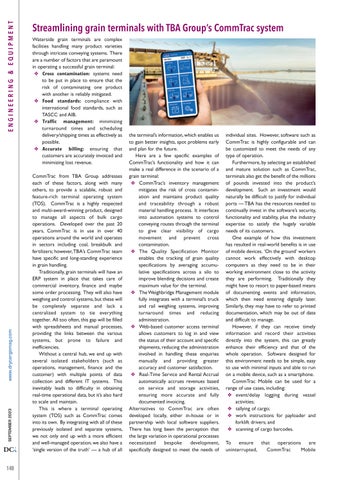ENGINEERING & EQUIPMENT www.drycargomag.com SEPTEMBER 2023
DCi 148
Streamlining grain terminals with TBA Group’s CommTrac system Waterside grain terminals are complex facilities handling many product varieties through intricate conveying systems. There are a number of factors that are paramount in operating a successful grain terminal: v Cross contamination: systems need to be put in place to ensure that the risk of contaminating one product with another is reliably mitigated. v Food standards: compliance with international food standards, such as TASCC and AIB. v Traffic management: minimizing turnaround times and scheduling delivery/shipping times as effectively as possible. v Accurate billing: ensuring that customers are accurately invoiced and minimizing lost revenue. CommTrac from TBA Group addresses each of these factors, along with many others, to provide a scalable, robust and feature-rich terminal operating system (TOS). CommTrac is a highly respected and multi-award-winning product, designed to manage all aspects of bulk cargo operations. Developed over the past 20 years, CommTrac is in use in over 40 operations around the world and operates in sectors including coal, breakbulk and fertilizers; however, TBA’s CommTrac team have specific and long-standing experience in grain handling. Traditionally, grain terminals will have an ERP system in place that takes care of commercial inventory, finance and maybe some order processing. They will also have weighing and control systems, but these will be completely separate and lack a centralized system to tie everything together. All too often, this gap will be filled with spreadsheets and manual processes, providing the links between the various systems, but prone to failure and inefficiencies. Without a central hub, we end up with several isolated stakeholders (such as operations, management, finance and the customer) with multiple points of data collection and different IT systems. This inevitably leads to difficulty in obtaining real-time operational data, but it’s also hard to scale and maintain. This is where a terminal operating system (TOS) such as CommTrac comes into its own. By integrating with all of these previously isolated and separate systems, we not only end up with a more efficient and well-managed operation, we also have a ‘single version of the truth’ — a hub of all
the terminal’s information, which enables us to gain better insights, spot problems early and plan for the future. Here are a few specific examples of CommTrac’s functionality and how it can make a real difference in the scenario of a grain terminal: v CommTrac’s inventory management mitigates the risk of cross contamination and maintains product quality and traceability through a robust material handling process. It interfaces into automation systems to control conveying routes through the terminal to give clear visibility of cargo movement and prevent cross contamination. v The Quality Specification Monitor enables the tracking of grain quality specifications by averaging accumulative specifications across a silo to improve blending decisions and create maximum value for the terminal. v The Weighbridge Management module fully integrates with a terminal’s truck and rail weighing systems, improving turnaround times and reducing administration. v Web-based customer access terminal allows customers to log in and view the status of their account and specific shipments, reducing the administration involved in handling these enquiries manually and providing greater accuracy and customer satisfaction. v Real-Time Service and Rental Accrual automatically accrues revenues based on service and storage activities, ensuring more accurate and fully documented invoicing. Alternatives to CommTrac are often developed locally, either in-house or in partnership with local software suppliers. There has long been the perception that the large variation in operational processes necessitated bespoke development, specifically designed to meet the needs of
individual sites. However, software such as CommTrac is highly configurable and can be customized to meet the needs of any type of operation. Furthermore, by selecting an established and mature solution such as CommTrac, terminals also get the benefit of the millions of pounds invested into the product’s development. Such an investment would naturally be difficult to justify for individual ports — TBA has the resources needed to continually invest in the software’s security, functionality and stability, plus the industry expertise to satisfy the hugely variable needs of its customers. One example of how this investment has resulted in real-world benefits is in use of mobile devices. ‘On the ground’ workers cannot work effectively with desktop computers as they need to be in their working environment close to the activity they are performing. Traditionally they might have to resort to paper-based means of documenting events and information, which then need entering digitally later. Similarly, they may have to refer to printed documentation, which may be out of date and difficult to manage. However, if they can receive timely information and record their activities directly into the system, this can greatly enhance their efficiency and that of the whole operation. Software designed for this environment needs to be simple, easy to use with minimal inputs and able to run on a mobile device, such as a smartphone. CommTrac Mobile can be used for a range of use cases, including: v event/delay logging during vessel activities; v tallying of cargo; v work instructions for payloader and forklift drivers; and v scanning of cargo barcodes. To ensure that operations are uninterrupted, CommTrac Mobile
